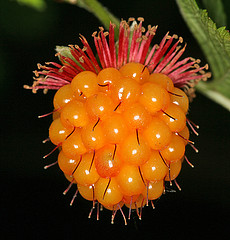Classification
Domain: Eukarya
Rubus Spectabilis falls under the Eukarya domain. Within this
domain, organisms contain eukaryotic cells. These cells have
membrane-bound organelles and have a nucleus.
| Rubus spectabilis drupelet |

Kingdom: Plantae
This organism contains cell walls with cellulose and it is
photosynthetic.
Phylum: Magnoliophyta
Contains endosperm within the seeds, produces fruits that
contain seeds, and flowers.
|
Order: Rosales
Mostly woody plants, such as shrubs. This shrub contains
prickles 2 to 3mm long that break off easily.
Family: Rosaceae
Typically the flowers are shallowly cup-shaped and produce
nectar. Flowers of this species contains a type of hypanthium.
Stepals, stamens, and petals rise from the rim of this. Stipules
are found at the base of the leaf stalk.
Genus: Rubus L.
Woody stems that contain prickles, bristles, spines, and
gland-tipped hairs. It produces fruit, which are an aggregate of
drupelets.
Species: Rubus Spectabilis
Grows in cool, moist soil along coastal Alaskan through
Northern America. There are 3 leaflets per leaf, which are one
to three inches long and dark green on top and light green
below. Flowers occur singularly or in clusters of two or three
and range in color from pink to dark red.

This phylogenetic tree above shows the relationship from the Kingdom Plantae to the species Rubus spectabilis. The top of the tree is determined by morphology, but as you move down the tree the location of species is determined by DNA sequencing.

This phylogenetic tree shows ancestral relations for the Rosaceae family. The tree in particular is based mainly off of morphological characteristics. As you move farther right DNA and RNA sequencing begin to determine the locations.
